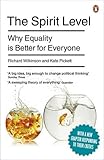Mazin Sidahmed “Ramen is displacing tobacco as most popular US prison currency, study finds” https://www.theguardian.com/us-news/2016/aug/22/ramen-prison-currency-study *1
刑務所の囚人間にはシャバとは異なった通貨が流通している。それはこれまでは主に「煙草」だったが、最近では「ラーメン」が基軸通貨化しているという。アリゾナ大学の大学院生Michael Gibson-Light氏*2の研究による。Gibson-Light氏は「監獄における労働」というより広いテーマの下、約60名の囚人にインタヴューした。
ここでsoupは換喩的にラーメンを指示している。
He found that the instant soup has surpassed tobacco as the most prized currency at the prison. He also analyzed other nationwide investigations that he says found a trend towards using ramen noodles in exchanges.“One way or another, everything in prison is about money,” one soft-spoken prisoner named Rogers said in the report. “Soup is money in here. It’s sad but true.”
「コスト削減」へのプレッシャーと囚人数の増加によって、米国の刑務所の食糧事情は質・量ともに悪化している。刑務所人口の増加はそれ自体が貧富の格差拡大の指標であり(Cf. Richard Wilkinson & Kate Pickett The Spirit Level: Why Equality is Better for Everyone*3, Chapter 11)、要するに「ラーメン」の擡頭は新自由主義のおかげということになる。
The study paints a bleak picture of the state of food available at the prison. Gibson-Light found that black-market food became more valuable after control over food preparation switched from one private firm to another in the early 2000s.“That change was part of a cost-cutting measure,” Gibson-Light said. “With that change that resulted in a reduction in the quantity of the food the inmates were receiving.”
Inmates at the prison Gibson-Light studied went from receiving three hot meals a day to two hot meals and one cold lunch during the week, and only two meals for the whole day on the weekend.
The phenomenon is described by Gibson-Light as “punitive frugality”. Spending on corrections has not kept pace with the number of inmates in prisons since 1982, the report found.
AdvertisementPrisoners said that they did not have enough calories to see them through the day, so ramen provides an additional hit.
“I save all my meals to eat at once so I can actually get full,” a prisoner named “DS” said.
The little food that is available is usually of extremely poor quality. Correctional officers warned Gibson-Light not to eat it, as it might result in food poisoning. One corrections officer recalled that he once examined the food in the kitchen and found a box that contained “nasty looking full chickens” that was boldly marked several times with the words “not for human consumption”.
The lack of food and the poor quality have contributed to ramen’s popularity. Gibson-Light found that even at prisons where tobacco has been banned or other items were more popular to trade– such as stamps and envelopes – there has been a shift towards food.

The Spirit Level: Why Equality is Better for Everyone
- 作者: Richard Wilkinson,Kate Pickett
- 出版社/メーカー: Penguin
- 発売日: 2010/11/04
- メディア: ペーパーバック
- この商品を含むブログを見る
さて、最近米国では、〈塀の中のラーメン〉というテーマは〈塀の外〉でも注目されているようだ。例えば、Gustavo “Goose” Alvarezという元囚人が上梓したPrison Ramenという本*4;
At the prison from the study, ramen cost 59 cents at the commissary but would be exchanged for items worth more in value. For instance, a sweatshirt – worth $10.81 – can be bought for two packs of ramen. Five tailor-made cigarettes – worth $2.00 – can be bought for one pack of ramen. Acquiring fresh vegetables to cook with was extremely highly regarded, Gibson-Light said. Inmates would use ramen to buy onions or zucchinis stolen from the kitchen.Others cleaned inmates’ bunks for one pack of ramen – referred to as soup – a week, or did laundry or gambled with it.
It can get dangerous when ramen is purchased at illegal inmate stores, as customers often purchase items on credit. Failure to pay back debts can result in fights or worse.
“I’ve seen fights over ramen,” one inmate said. “People get killed over soup.”
Ramen noodles have long been known to be a popular dish in prisons. Gustavo “Goose” Alvarez, who spent more than a decade incarcerated on a weapons charge, wrote a book on its popularity, Prison Ramen: Recipes and Stories From Behind Bars.He was inspired to write the book after a race riot in 2009 led to a standoff between a group of Hispanic and African American inmates. An older inmate quelled the dispute and the two groups resolved the tensions by cooking a feast together, largely with ramen noodles.
The book, released last year, includes several recipes such as Ramen Tamale, using Doritos, canned pork and beans, and ramen. It recommends mixing strawberry jelly with soy sauce to make teriyaki, to go with Cheesy Meat Tacos. The book also includes the favorite ramen recipes of celebrities such as Shia LeBeouf*5 and Guns N’ Roses*6 guitarist Slash.
*1:See also American Sociological Association “Ramen noodles supplanting cigarettes as currency among prisoners” http://www.eurekalert.org/pub_releases/2016-08/asa-rns081616.php
*2:http://www.u.arizona.edu/~mgibson/ https://sociology.arizona.edu/user/michael-gibson-light
*3:See http://d.hatena.ne.jp/sumita-m/20160809/1470761804
*4:See eg. “Behind Bars, Cheap Ramen Is As Good As Gold” http://www.npr.org/sections/thesalt/2015/11/04/454671629/behind-bars-cheap-ramen-is-as-good-as-gold
*5:See eg. https://en.wikipedia.org/wiki/Shia_LaBeouf https://ja.wikipedia.org/wiki/%E3%82%B7%E3%83%A3%E3%82%A4%E3%82%A2%E3%83%BB%E3%83%A9%E3%83%96%E3%83%BC%E3%83%95
*6:Mentioned in http://d.hatena.ne.jp/sumita-m/20160417/1460907693